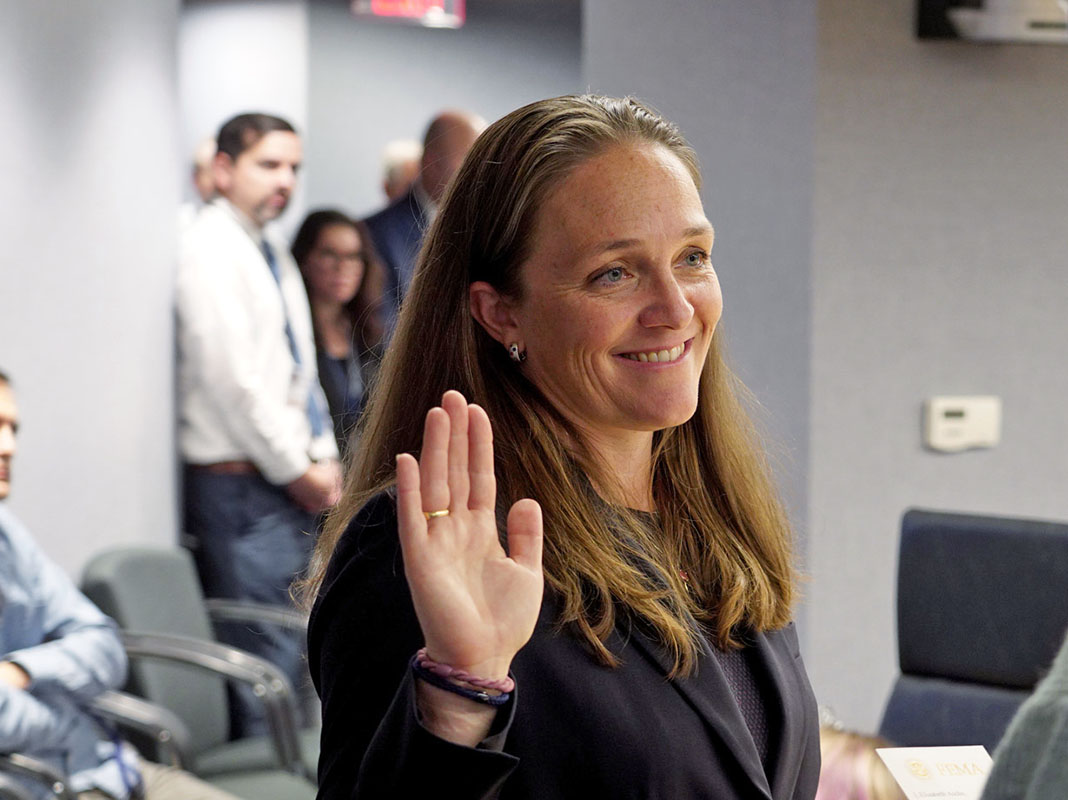Throughout March, FEMA joins the nation in celebrating Women’s History Month.
At FEMA, there is no short supply of women who have helped shape the emergency management field. Today, we are led by Deanne Criswell, FEMA’s first permanent female Administrator. Administrator Criswell serves as a role model for women, fostering the shift to greater representation and inclusivity in the field of emergency management. This work, carried out by FEMA leaders across the agency, embodies this year’s Women’s History Month theme: “women who advocate for equity, diversity and inclusion.”
One of the women leading these efforts at FEMA is Deputy Director of Individual Assistance Elizabeth Asche, PhD. We asked her more about her role at the agency and what it means to be a leader in equity, diversity and inclusion.

Asche was sworn in as Deputy Director of Individual Assistance in November 2022.
What is your role at FEMA?
I am the Deputy Director of the Individual Assistance (IA) Division within FEMA’s Recovery Directorate. In this role I dedicate my time to helping people recover from disasters while also working to mitigate the impacts of future disasters. Prior to joining IA in November 2022, I spent 17 years working in and around the National Flood Insurance Program (NFIP) where I focused on data informed policymaking, understanding mitigation behavior, and evolving the NFIP to meet survivor needs.
Can you describe how your team/FEMA supports Individuals and families after a disaster?
In IA, we help survivors rebuild their homes and lives. After a federal disaster is declared by the President that turns on our IA programs, we get to work immediately to ensure disaster survivors have access to programs and services to jumpstart their recovery. The IA team spans from manning FEMA's helpline to interacting with survivors in Disaster Recovery Centers, shelters, on their doorstep, or in their neighborhood to supporting our interagency and voluntary partners who provide direct support help individuals recover. We provide direct assistance, coordinate mass care activities, and oversee grants like Crisis Counseling and Disaster Case Management to provide critical support in both immediate and long-term recovery. We connect survivors with non-governmental organizations and other levels of government that can provide care deliver assistance beyond our ability to help. We are a beacon of hope for survivors on the worst day of their lives.
This month, FEMA is rolling out changes to the Individual Assistance Program. What are those changes?
FEMA is making major changes to its IA programs to address historic challenges faced by disaster survivors by removing barriers to access and reducing the burden of disaster recovery. These initiatives will establish new benefits, cut red tape, expand eligibility and simplify the application process. We intend to improve the survivor experience, speed recovery, and increase the chances a survivor will fully recover. You can read more about the IA Reform in the agency’s recent news release.
How do these changes support equity, diversity and inclusion?
IA Reform represents the most significant update to survivor assistance in the last 20 years. The IA reforms reduce survivor burden and acknowledge that the program did not meet the needs of today’s survivors. These updates are based on direct feedback we’ve received from survivors, which in my opinion is the absolute keystone supporting equity, diversity and inclusion. They build on years of hard work and engagement from a cross-FEMA team dedicated to modernizing and simplifying the IA experience. Bottom line, these changes are about meeting survivors where they are with holistic care and empathy—getting more people the right assistance at the right time.
What does it mean to you, to be a leader that supports equity, diversity and inclusion?
Part of supporting equity, diversity and inclusion is about recognizing the complicated fabric that makes up the diverse communities where we deliver our programs. To do our best for disaster survivors, we need to listen to their feedback, seek to understand their experiences, and relentlessly quest to remove barriers to accessing our programs.
What does Women’s History Month and the theme of the month mean to you, personally?
Women’s History Month is an opportunity to celebrate the accomplishments of all women. It highlights the achievements of women both past and present who have helped build and mold this country. This month, I am taking time to reflect on my role as a woman leader finding her voice, as a mother teaching her daughter about the barriers of history and the endless possibilities of the future, and as a proud servant of the agency that shows up on a disaster survivor’s worst day to make the future look a little bit brighter.

Asche was sworn in as Deputy Director of Individual Assistance in November 2022. Her daughter attended the ceremony.
This year’s theme is especially poignant for me because part of the reason I joined IA after a long career in NFIP was a recognition that not all survivors can afford insurance—and a desire to do as much as I can to help people who may not have the means to be able to help themselves. There is no ‘one-size-fits-all’ solution in disaster recovery and solving recovery challenges requires approaching each community, each survivor, with intentionality, empathy, and dignity. It means understanding our collective history while planning for the future. It means building an inclusive work culture as we grow our team and collaborate across multiple geographies.
For all those reasons, this year’s Women’s History Month theme deeply resonates. I can think of no place I’d rather be than right here in IA supporting my team, and all the work they do to support survivors.

